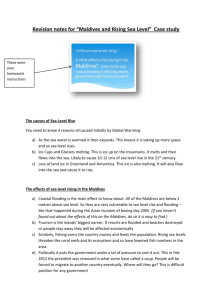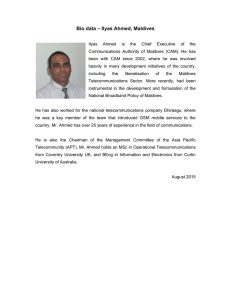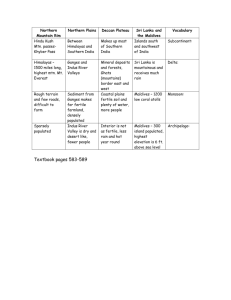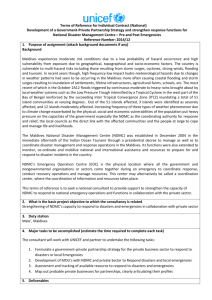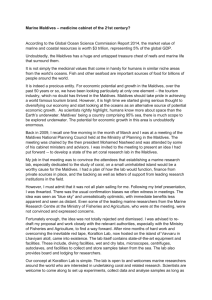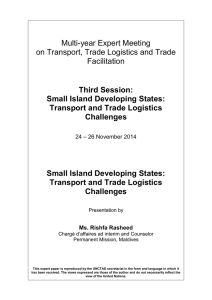I C T
advertisement
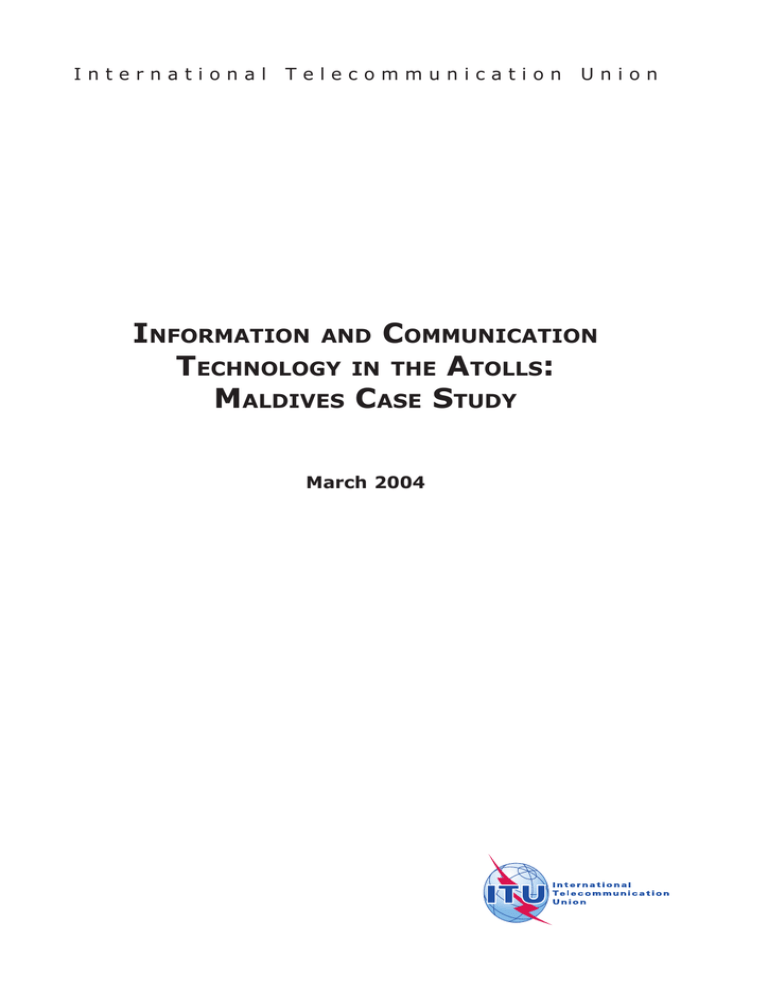
International Telecommunication Union INFORMATION AND COMMUNICATION TECHNOLOGY IN THE ATOLLS: MALDIVES CASE STUDY March 2004 This report was prepared by Michael Minges and Vanessa Gray. Formatting and cover design was done by Nathalie Rollet. The report is based on research carried out from 28 May - 3 June 2003 as well as articles and reports noted in the document. The assistance of the Ministry of Communication, Science and Technology and Mohamed Amir and Zulaikha Ibrahim was indispensable. Equally, the report would not have been possible without the cooperation of Maldivian organizations. The list of organizations met is attached in the annex to this report. The assistance of Dhiraagu, particularly their comments on earlier versions of this report, is highly appreciated. The report is one of series examining the Internet in developing nations. Additional information is available on the ITU's Internet Case Study web page at: http://www.itu.int/ITU-D/ict/cs. The report may not necessarily reflect the opinions of the ITU, its members or the government of the Republic of Maldives. The title refers to the unique geographical situation of the Maldives. The country consists of 1'190 islands in 26 atolls. The word atoll comes from the Maldivian language and refers to a circular reef or ring of coral islands surrounding a lagoon. © ITU 2004 ii Contents 1. Introduction ........................................................................ 1 2. Background ......................................................................... 3 2.1 Geography .......................................................................... 3 2.2 Population ........................................................................... 4 2.3 Economy ............................................................................. 5 2.4 Quality of Life ...................................................................... 6 2.5 Government ........................................................................ 6 3. Pervaisveness ...................................................................... 8 3.1 Telephony ........................................................................... 8 3.2 Computers and Internet ...................................................... 10 3.3 Mass media ....................................................................... 12 4. Sector absorption .............................................................. 14 4.1 Education .......................................................................... 14 4.2 Business ........................................................................... 15 4.3 Government ...................................................................... 15 4.4 Health .............................................................................. 16 5. Connectivity ....................................................................... 19 5.1 International and domestic backbone .................................... 19 5.2 Exchange points ................................................................. 20 5.3 User access methods .......................................................... 20 6. Market ............................................................................... 23 6.1 Overview .......................................................................... 23 6.2 Fixed ................................................................................ 26 6.3 Mobile ............................................................................... 26 6.4 Internet ............................................................................ 26 7. Information Society ........................................................... 29 7.1 Economic impact ................................................................ 29 7.2 Employment impact ............................................................ 31 7.3 Social impact ..................................................................... 31 7.4 E-Government ................................................................... 34 7.5 Education .......................................................................... 35 8. Conclusions ....................................................................... 44 8.1 A successful SIDS .............................................................. 44 8.2 Assessing the Maldives ....................................................... 45 8.3 Recommendations .............................................................. 49 Annex 1: Meeting schedule ..................................................... 55 Annex 2: Acronyms ................................................................. 56 Annex 3: ICT statistics ............................................................ 57 Annex 4: Bibliography ............................................................. 58 iii Figures 2.1 Map of Maldives ................................................................... 3 2.2 Geographic and demographic characteristics ............................ 4 2.3 Tourists welcome .................................................................. 5 3.1 Universal telephone service and access ................................... 8 3.2 Mobile in Maldives ................................................................ 9 3.3 Mobile pricing .................................................................... 10 3.4 Internet users and pricing ................................................... 11 4.1 Health system in the Maldives .............................................. 16 5.1 So close and yet so far ........................................................ 19 5.2 Mobile data ....................................................................... 21 7.1 Transforming the Maldives into an information society ............ 29 7.2 Telecom economic impact .................................................... 30 7.3 Maldives untapped Internet market ...................................... 37 7.4 Going abroad for higher education ........................................ 39 8.1 Catching up ....................................................................... 45 8.2 Maldives in the DAI ............................................................ 46 Tables 2.1 Population indicators ............................................................ 4 2.2 Ranking Maldives human development .................................... 6 4.1 Maldives at school .............................................................. 14 4.2 Health online ..................................................................... 17 5.1 International connectivity .................................................... 20 6.1 Maldives telecommunications milestones ............................... 23 6.2 Maldives Telecommunication Policy ....................................... 24 7.1 Private sector ICT courses ................................................... 40 8.1 Maldives SWOT .................................................................. 48 Boxes 7.1 e-Maldives ......................................................................... 30 7.2 Tourism and telecommunications: A marriage made in heaven ... 31 7.3 ICT in the Atolls ................................................................. 32 7.4 ICT potential for women ...................................................... 36 7.5 Increasing awareness and attracting new customers ............... 38 8.1 State of the Internet in Maldives .......................................... 47 iv 1. Introduction 1. Introduction Information and communication technology (ICT) is a key issue for members of the International Telecommunication Union (ITU), the United Nations specialized agency for telecommunications. In that respect, the ITU has carried out a series of case studies researching ICT in different nations. 1 This study looks at ICT diffusion in the Republic of Maldives. It touches on specific problems such as isolation and undersized markets that small island developing states such as the Maldives face in adopting ICT.2 The study also examines how the Maldives is evolving into an information society, particularly relevant in the context of the World Summit on the Information Society (WSIS), the first phase of which was held in Geneva, Switzerland in December 2003.3 • geographic dispersion: a measure of the concentration of ICT, from none or a single city to nationwide availability. • sector absorption: a measure of the degree of utilization of ICT in the education, commercial, health care and public sectors. • connectivity infrastructure: a measure based on international and domestic backbone bandwidth, exchange points, and user access methods. • organizational infrastructure: a measure based on the state of the ICT industry and market conditions. The organization of this report is based on a framework developed by the Mosaic Group.4 The scope has been widened to incorporate telecommunication networks such as the fixed-line and mobile telephone networks. Mosaic considers six factors as follows: • sophistication of use: a measure characterizing usage from conventional to highly sophisticated and driving innovation. • The report also considers other factors not included in the above framework such as the evolution to an information society, pricing and government policies. pervasiveness: a measure based on users per capita. 1 Maldives Internet Case Study 1 2 3 4 Resolution 31, “Telecommunication infrastructure and information and communication technologies for socioeconomic and cultural development” calls upon the ITU to “organize, conduct or sponsor necessary studies to bring out, in a different and changing context, the contribution of ICTs to overall development.” ITU. 2003. Final Acts of the Plenipotentiary Conference (Marrakesh, 2002). The ITU notes, “… small island nations and communities face particular problems in bridging the digital divide.” See Resolution 129 (Marrakesh, 2002) in ITU. 2003. Final Acts of the Plenipotentiary Conference (Marrakesh, 2002). Small island developing states (SIDS) form an official grouping in the UN system. For a list of the 46 SIDS see http://www.un.org/special-rep/ohrlls/sid/list.htm. [Accessed 4 February 2004]. The WSIS Declaration of Principles makes special mention of the Small Island Developing States noting they have particular needs. For more on WSIS see the web site at: www.itu.int/wsis/index.html. [Accessed 4 February 2004]. Since the Global Diffusion of the Internet (GDI) project’s inception in 1997, the Mosaic Group has studied the Internet in nearly 30 countries. See http://mosaic.unomaha.edu/gdi.html. [Accessed 4 February 2004]. 2 2. Background 2. Background 2.1 Geography1 distance southwest of Sri Lanka. Only 199 islands are inhabited and almost 99 percent of the country’s surface is ocean. Archeologists believe that the islands have been inhabited for over two thousand years. The name of the country is derived from the Sanskrit word, Maladiv, meaning a garland of islands. Administratively the Maldives is divided into 20 atolls. The Republic of the Maldives consists of a chain of 1’190 coral islands spread over 100’000 square kilometers (820 kilometers from north to south) and 26 natural atolls2 , in the north central Indian Ocean (Figure 2.1). The northernmost atoll is located some 600 kilometers southwest of India and Male’, the capital, is at a similar Figure 2.1: Map of Maldives Source: Dhiraagu. 3 Maldives Internet Case Study 2.2 Population3 Table 2.1: Population indicators According to the 2000 census, the population of the Maldives was 270’101, growing at two per cent a year during 1995-2000. The mid-year 2003 population was estimated at 285’066. The most populated island is Male’, where almost 30 percent of the population live on some 1.77 square kilometres. This makes it one of the most densely populated capital cities in the world with over 41’000 people per square kilometre. The next most populated island has 9’500 inhabitants but most have less than 2’000 inhabitants (Figure 2.2). According to the national definition of urban, population residing outside of Male’ is considered rural (72.6 percent). The 2000 Census reported 40’912 households with an average size of 6.6. The large household size is explained by the tradition of living with the extended family. Item Total population 270’101 Growth (1995-2000) (%) 2.00 Urban population (%) 27.4 Population Density (per/km2) - Male’ 906 41'000 Age distribution (%): 0-14 15-64 65+ 40.7 55.1 3.7 Source: Ministry of Planning and National Development, Census 2000. sharing one culture, one language and one religion. Everyone speaks Dhivehi, an Indo-Aryan language that is unique to the country. English is widely spoken by government officials and in the tourist industry and business sector. It is also the language of instruction in secondary school. The official religion is Islam, with the majority Sunni Muslims. Ethnically Maldivians are Dravidian. While their origins go back to different groups, they are predominantly of Indian and Sri Lankan descendent. Maldivians are culturally homogeneous Figure 2.2: Geographic and demographic characteristics Number of inhabited islands by population size, 2001 (left) and distance of atoll capitals from Male', kilometres (right) Note: The total number of inhabited islands in the year 2000 was 200. In addition there were 111 nonadministrative islands including tourist resorts, industrial islands and islands used for other purposes. Source: ITU adapted from the Ministry of Planning and National Development. 4 2. Background 2.3 aftermath of the terrorist attacks of 11 September, the number of tourists dropped in 2001, the first ever annual decline. Economy The Maldives, classified as a Least Developed Country (LDC), has few natural resources and scarce arable land. According to the Asian Development Bank, “the combination of a small domestic market, remoteness, a dispersed population, and high internal transport costs poses formidable constraints to diversifying economic activity and delivering public services.”4 Despite these limitations the country’s economy has seen rapid growth, especially since the 1980s raising the Maldives from one of the 20 poorest countries in the 1970s to a middleincome country today. The two main engines of the economy are tourism and fishing, accounting for almost two fifths of Gross Domestic Product (GDP) (Figure 2,3, left). The tourism industry began around thirty years ago with two resorts and some 1’000 visitors. By 2002 tourism made up 30 percent of GDP and the number of tourists had grown to 485’000 (Figure 2.3, right). At the same time the country’s limited resource base and reliance on export-oriented activities makes it vulnerable to external shocks. In the The Maldives’ development challenges are closely linked to its geographic and demographic situation. While the country’s overall unemployment rate is low, a 1998 report found that 43 percent of the population, over 90 percent of which are outside Male’, live on less than US$ 1.3 a day. Reducing this regional divide is a major government concern. One cause is the difficulty of providing services to small and dispersed locations. In that respect, the government has a programme encouraging inhabitants to move to more populated islands. However many people are reluctant to leave. Besides vulnerability and regional inequity, the Maldives faces labour constraints. The population base is low and post-secondary training opportunities are limited. Consequently, the Maldives has to rely on expatriate workers (about one fourth of the labour force is foreign) and overseas educational institutions (to send students abroad for tertiary degrees). Figure 2.3: Tourists welcome Distribution of Gross Domestic Product, 2002 (left) and tourist arrivals, 000s, 1972-2002 (right) Contribution to GDP, 2002 Tertiary: Tourism 30% Other Tertiary sector 45% Secondary sector 15% Tourist arrivals, 000s Other Primary sector 3% 467 461 2000 2001 485 315 195 Primary: Fisheries 7% 120 1 1972 42 1980 1985 1990 Source: ITU adapted from the Ministry of Planning and National Development. 5 1995 2002 Maldives Internet Case Study Table 2.2: Ranking Maldives human development 2001 data from UNDP 2003 Human Development Report Ranking within groups Maldives Human Development Indicators Rank Indicator 86 South Asia Value Rank Overall Country Countries with similar income Rank Country (PPP) Rank Country 86 Maldives 52 Cuba (5'259) 62 Mauritius 66.8 99 Sri Lanka 77 Suriname (4'599) 71 St. Lucia Literacy 97 127 India 86 Maldives (4'798) 81 Fiji School enrolment 79 143 Nepal 92 Guyana (4'690) 86 Maldives 4'798 144 Pakistan El Salvador (5'260) 103 Cape Verde Life expectancy GDP per capita (US$, PPP) 105 Source: UNDP. 2.4 Small Island States Quality of Life 2.5 Economic growth in the Maldives has gone hand in hand with gains in human welfare. The United Nations Development Programme (UNDP) ranked the Maldives 86 th out of 176 countries in its 2003 Human Development Report. The ranking is based on a composite of four indicators: life expectancy, literacy, school enrolment and GDP per capita. The position of the Maldives, which places the country in the Medium Human Development group, is seven places higher than its GDP per capita rank, suggesting that it is doing better than average with regards to other indicators. For example the Maldives has a relatively high adult literacy rate compared to other countries with a similar income. Government Apart from brief interludes, the Maldives remained independent until 1887, when it became a British protectorate. It gained independence in 1965 and three years later it became a Republic. There are no structured political parties and candidates run on their personal qualifications. President Maumoon Abdul Gayoom is the second since independence and has been reelected every five years since 1978. The legislative assembly, the People’s Majlis, is also elected every five years. The President appoints eight members while two members are elected from each of the twenty administrative atolls. 6 2. Background 1 2 3 4 Parts of this section have been adapted from the “Country Profile” page of the Ministry of Trade, Industries and Labour website at http://www.investmaldives.com/home.htm. [Accessed 4 February 2004]. The word atoll comes from Dhivehi (the national language) and means a circular reef or ring of islands surrounding a lagoon. Parts of this section have been adapted from the Statistical Yearbook of Maldives and the Population and Housing Census of the Maldives 2000 available from the Ministry of Planning and National Development website at: http://www.planning.gov.mv. [Accessed 4 February 2004]. Parts of this section have been adapted from the Maldives page on the Asian Development Bank website at http://www.adb.org/Maldives/default.asp. [Accessed 4 February 2004]. 7 Maldives Internet Case Study 3. Pervaisveness Maldives has achieved universal access to telephone service. This is a remarkable accomplishment for a Least Developed Country (LDC). The five-year project to provide telephone service to all islands was fulfilled by the incumbent operator Dhiraagu as part of its license conditions. There were 30’056 fixed telephone lines at December 2003 for a telephone penetration of 10.5, the highest in the South Asia region and second highest among the LDCs. This chapter examines individual, household and community access to ICT (fixed and mobile telephones, computers and the Internet) as well as mass media (newspapers, radios and televisions) and compares the situation in the Maldives to other countries. 3.1 Telephony The Maldives has made tremendous progress in providing basic telephone access to its inhabitants. In 1999, it succeeded in providing telephone service to all 200 inhabited islands (Figure 3.1, left). Given the small size of most islands, this suggests that all inhabitants are within walking distance of a telephone. At least two payphones have been installed on each inhabited island, providing telecommunication access to 100 per cent of the population. Thus the Access to telecommunications is also being extended through the expansion of mobile cellular telephone services. Growth has been particularly high since the launch of pre-paid with the number of mobile subscribers surpassing fixed in April 2002 (Figure 3.2, left). Mobile is also well suited to the Maldivian environment of boat transport among the various Figure 3.1: Universal telephone service and access Percentage of population with access to fixed telephone and percentage of households with a fixed telephone, 1994-2003 (left) and distribution of fixed telephone lines by location, per cent, 2002 (right) Note: In the left chart, data for 2000 for the percentage of households with a telephone is from the Census. Data for other years is calculated based on the number of residential lines adjusted for the estimated number of second telephone lines in households. Source: ITU adapted from Dhiraagu and Ministry of Planning and National Development. 8 3. Pervaisveness Figure 3.2: Mobile in Maldives Fixed and mobile telephone subscribers per 100 inhabitants (left) and mobile telephone subscribers and population coverage (right) Fixed and mobile telephone per 100 inhabitants 40 35 30 25 20 15 10 5 Mobile passes fixed, Apr. 02 Pre-paid launched Sep. 01 Mobile telephone subscribers 70'000 33.8 Total 23.3 Conversion to digital mobile Nov. 99 Mobile 10.5 6.1 Fixed - 100% Pre paid Post paid Population Coverage 60'000 50'000 90% 80% 70% 40'000 60% 30'000 40% 50% 30% 20'000 20% 10'000 10% 1996 97 98 99 2000 01 02 03 0% 1997 98 99 2000 01 02 03 Source: ITU adapted from Dhiraagu. islands since cellular signals are available at sea in most atolls where there is mobile coverage. Mobile cellular coverage stood at 71 per cent in September 2003 with 82 islands and all resorts covered. At December 2003, there were 66’466 mobile subscribers (of which 80 per cent were pre-paid) for a density of 23.3 (32.8 if effective coverage is used). This is the highest in South Asia as well as among the LDCs. the second line for Internet access. There are no data on the number of households with a mobile telephone. Given the growth in cellular and the fact that residential fixed telephone service is not available on most islands, it is likely that universal service will most likely be accomplished through mobile. This is particularly important since the growth rate of fixed telephones in households has been stagnant over the last few years. According to the 2000 Census, 23 per cent of homes in the Maldives had a fixed telephone line. This is up from an estimated 13 per cent in 1990. There is a large difference in universal service —defined as the number of households with a telephone— between Male’ and the atolls. 71 per cent of household phones are in Male’ which has a home fixed telephone penetration of 68.7 per cent compared to 8.7 in the atolls. One reason is that residential telephone service is only available on 12 islands. Male’ also has a high second home telephone line ratio of 1.3. This is partly explained by the fact that many households have extended members residing in them (e.g., parents with grown children, relatives from the atolls, etc.). It could also partly be explained by usage of Universal telephone access policy has been based on subsidization of local fixed service. Tariffs for local telephone service have not changed since 1994. There is a nationwide connection charge of Rf 1’720 (US$ 134) and monthly subscription charge of Rf 30 (US$ 2.33) for fixed telephone service. Call charges are Rf 0.25 (US¢ 1.95) per minute (there is no off-peak rate) for fixed to fixed and Rf 2.00 (US¢ 16) for fixed to mobile. It would not appear that affordability is a major problem. The monthly subscription charge and 100 minutes of local calls would amount to 2.3 per cent of per capita income. The one time installation charge amounts to 5.9 per cent of per capita income. Technically there is no waiting list (it stood at 113 at the end 9 Maldives Internet Case Study Figure 3.3: Mobile pricing Comparison of monthly charges for mobile and fixed services in the Maldives, Rf, 2003 (left) and price of one minute mobile call, US$, 2003, South Asia nations (right) Monthly charge Call charge (per minute) Usage charge Total charge Mobile Fixed 100 (US$ 7.78) 30 (US$ 2.33) Note One minute mobile call, peak rate, US$, 2003 30 days validity for pre-paid; monthly rental for fixed telephone. 2.7 (US¢ 21) 0.25 (US¢ 1.95) Peak. For fixed, refers to local call. Included in voucher 9.26 (US$ 0.72) (37 minutes) Mobile allows 37 minutes of peak time conversation with Rf 100 voucher. 100 (US$ 7.78) 39.26 (US$ 3.06) India Nepal $0.05 $0.06 Pakistan Bangladesh $0.10 $0.10 Sri Lanka $0.11 South Asia $0.12 Maldives Source: ITU adapted from Dhiraagu, World Telecommunication Development Report 2003. One way of analyzing the pentotial for mobile-fixed substitution is to compare the monthly costs of service. The cheapest pre-paid voucher is Rf 100 which allows 37 minutes of peak time conversation with an expiry of 30 days. This is more than twice as much as what it would cost a fixed line subscriber (Figure 3.3, left). This mobile premium is also reflected in regional comparisons. The Maldives has the highest per minute mobile call charges in the South Asia region (as well as the highest connection and SMS prices, Figure 3.3, right). Competition explains part of the difference with all South Asian nations except Maldives and Nepal having more than one mobile operator. However Nepal still has significantly lower mobile tariffs than Maldives. of 2002) with service available on demand in the islands there are facilities. The main problem to expanding individual and household access is a lack of service availability: • Around sixteen per cent of households do not have electricity. • At September 2003, 29 per cent of the population were not covered by the mobile cellular service. • Residential fixed telephone service is available on twelve islands covering around forty per cent of households. 3.2 As mentioned, mobile service could be a solution for achieving higher levels of universal service in the Maldives. For that to happen, coverage needs to be expanded and pricing reduced. Coverage has steadily increased and is forecast to reach almost three quarters of the population by the end of 2003. This suggests that assuming the service were affordable, almost three quarters of households in the Maldives could have a mobile phone. Computers and Internet There were an estimated 10’000 PCs in the country at the end of 2002. There is no local assembly and all PCs are imported. Import taxes on PCs are a moderate five per cent compared to an average of 21 per cent for other products. According to the Population and Housing Census 2000, the percentage of homes with a personal computer (PC) was 6.2. Like other ICT, 10 $0.2 3. Pervaisveness Figure 3.4: Internet users and pricing Internet users and per 100 inhabitants, Maldives (left) and Internet access prices for 20 hours of dial-up use per month, US$, 2003, South Asia (right) Note: The right chart show the price of dial-up Internet use for 10 hours of peak and 10 hours of off-peak use per month. Telephone usage charges are included but not the line rental. In the case of the Maldives, there is no separate charge for telephone usage for Internet access. Source: ITU World Telecommunication Indicators database. the geographic distribution of PCs is uneven. Home PC penetration in Male’ is 21.9 per cent compared to 1.3 per cent in the atolls. It is estimated that approximately 14 per cent of homes in Male’ had Internet access in October 2001 suggesting that more than half the home PCs have a connection.1 Dhiraagu has had a program since 2000 with leading vendors to sell PCs already Internet ready. 2 Dhiraagu offers nationwide “pay as you go” dial-up Internet access, charging the same rate regardless of location. This means that dial-up Internet access is available anywhere in the Maldives where there is a telephone line. Around 500 users are also utilizing their mobile phones to access the Internet. • The number of telephone lines using the Dhiraagu “pay as you go” dial-up service is around 5’000 each month. 3 Dhiraagu estimates that on average two people use each line. That makes 10’000 users. • Other customers with dedicated and broadband subscriptions such as government offices and large businesses many of which have LANs. This accounts for another estimated 5’000 users. Internet penetration in the Maldives ranks it number one among South Asian nations, second among LDCs and 14th out of 38 small island states. The figure of 15’000 Internet users would not include people using Internet cafes. Thus, it is a conservative figure. A survey of the number of Internet users is critical to more accurately determine Internet usage in the country and to explore the digital divide in greater detail. It is estimated that 80 per cent of telephone lines used for Internet access are in Male’. There are no official surveys on the number of Internet users in the country. Dhiraagu estimates that there were 15’000 users at the end of 2002 for a penetration of 5.3 per cent of the population. The estimated number of users is based on the following methodology: 11 Maldives Internet Case Study Internet access, typically provided as a community centre type of operation. The monthly subscription is Rf 200 per month (normally 2’000 for nonresidential islands) and Rf 1’720 for the installation. Dhiraagu also gives a twenty percent discount for calls. Dhiraagu offers several different Internet packages, all of which include telephone usage charges. Internet on demand—to a toll-free number—is Rf 0.55 (US¢ 0.4) per minute. This is the most popular option and used by the majority of dial-up users. Several monthly packages are available with per minute charges ranging from Rf 0.42 to Rf 0.33. These packages are used by less than 20 per cent of dial-up users. The entry-level package is Rf 100 (US$ 7.78) for four hours of usage. This amounts to 4.1 per cent of per capita income. Though not exorbitant, this package does not provide many hours of use inhibiting experimentation and the development of a vibrant Internet community. In terms of regional comparisons, Internet prices are high in the Maldives. The country has the second highest prices in South Asia, more than twice as much as what most other countries in the region charge (Figure 3.4, right). 3.3 Mass media According to the 2000 Census, 56.7 per cent of homes had a television set. Of those, 85.7 per cent had a VCR/DVD player and nine per cent had a satellite dish. There are also between 5’000 - 7’000 cable television subscribers in Male’. Broadcast media are government owned. The Voice of Maldives operates two radio channels one on the AM and the other on the FM band. It also provides audio streaming from its web site <www.vom.gov.mv>. Maldives Television operates one terrestrial channel. Limited terrestrial-based broadcasting explains the high demand for pre-recorded media and multi-channel television. There are a number of public Internet facilities. Dhiraagu has eight Internet cafes. Charges at its café in Male’ are Rf 10 (US$ 0.78) for ten minutes. In addition, Dhiraagu provides a 75 per cent discount for educational institutions and encourages private companies to set up Internet cafes. There are 55 islands using dial-up There are two daily newspapers with web sites, Haveeru and Miadu. They publish in Dhivehi with some Englishlanguage pages. The largest, Haveeru, reports a daily readership of 69.8 per cent of the population.4 12 3. Pervaisveness 1 2 3 4 Ministry of Communication, Science and Technology. e-Maldives: The Republic of Maldives National Information and Communications Technology Policy. Draft. 2003. Dhiraagu. 19 September 2000. “Personal Computers Available “Dhivehinet-Ready” from Leading Maldives PC Vendors.” Press Release. http://www.dhiraagu.com.mv/newsdesk/index.php?newsid=159. [Accessed 5 February 2004]. This service requires no registration and is available from any telephone line in the country at the same rate. Speed is 56 kbps in Male’ some other islands. The maximum speed outside Male’ depends on the switch radio network interface. See the Haveeru web site at http://www.haveeru.com.mv/ads. [Accessed 5 February 2004]. 13 Maldives Internet Case Study 4. Sector absorption outside Male’ and of the 1’481 higher secondary school students, 84 per cent are studying in the capital. Primary and secondary schools in Male’ have computer labs with access to the Internet. Some schools in the atolls are equipped with computers while a few have Internet access, typically restricted to staff. This chapter identifies the degree of utilization of Information and Communication Technology (ICT) in different sectors of the economy. 4.1 Education The Ministry of Education (MOE, <www.moe.gov.mv>) is increasingly integrating ICT into its daily work. A 128 kbps leased line provides almost all staff at the ministry headquarters with access to the Internet. There are plans to expand the Ministry’s Local Area Network (LAN) and to connect all educational institutions in the atolls to a Wide Area Network (WAN). The Ministry’s web site offers statistics about the educational system, a directory providing links to web pages for four schools and information about studying abroad including scholarship application forms. The incumbent telecommunication operator Dhiraagu’s Internet for Schools initiative provides discounted access. 1 Launched in November 2001, schools receive free installation, do not pay monthly subscription charges and get a 75 per cent discount on usage charges for dial-up access.2 In July 2003 Dhiraagu introduced an Asymmetric Digital Subscriber Line (ADSL) 256 kbps package for educational institutions, which provides schools located in Male’ unlimited usage for a fixed monthly rate of Rf 5’000 (US $389). Discounted Internet access is also available for private educational institutions that have been certified by the Maldives Accreditation Board. While every inhabited island in the Maldives has a primary school, secondary education is only provided at atoll capitals. Higher secondary schools exist in only three atolls Table 4.1: Maldives at school March 2003 Schools Students Teachers Male’ Atolls Total Male’ Atolls Total Male’ Atolls Total Total 29 305 334 24’805 68’331 93’136 4’168 1’337 5’505 Primary (6-12 years) 16 213 229 13’763 52’406 66’169 2’951 693 3'644 Lower secondary (12-15 years) 11 89 100 9’803 15’683 25’486 1’194 566 1’760 Higher secondary (16-17 years) 2 3 5 1’239 242 1’481 23 78 101 Source: Ministry of Education. 14 4. Sector absorption Distance education is used to a limited extent. MCHE provides educational services to the atolls through the Centre of Open Learning. Students from over 100 islands meet in one of the 15 centres that are located across the country once a month for a period of two days. The MCHE provides the educational material. Some 50 percent of the exams are taken under supervision. ICT is primarily used for telephone and email contacts between students and tutors (assuming the services are available). The Distance Education Project has made available the programmes of India’s Indira Gandhi National Open University (IGNOU) to Maldivian students for over a decade. The Tertiary Institute of Open Learning at MCHE coordinates the project. The Indian government provides scholarships for Maldivian students to pursue studies via the IGNOU distance mode. The government contracts the private sector to install and maintain ICT equipment for schools that lack the expertise. In some schools that are poorly equipped, mainly in the atolls, parents have donated computers.3 The Sixth National Development Plan (NDP) 4, which defines government policies for the period 2001-2005, highlights the need to expand and promote ICT in education, including the reduction of Internet charges and improved connectivity. The NDP also emphasizes the use of ICT for management purposes. The MOE is drafting a strategy document that discusses ways of using ICT as a tool to improve educational institutions by making them more efficient und improving communication. Goals include establishing a school network to share educational resources and making use of distance education. The draft identifies a number of concrete goals such as providing all schools with a computer, providing all teachers with email and providing Internet access to all schools. 4.2 Business There are no formal statistics regarding ICT use in the business sector although one 2001 survey found that 86 per cent of businesses in Male’ had Internet access.6 Ancillary evidence suggests that most large companies and certain industries would have PCs and access to the Internet. This is particularly true in the tourism industry where most of the resorts have web sites or email.7 There are five companies in the banking sector; they all have email and one has a web site.8 The Maldives Customs reports that 85 per cent of declarations from substantial importers are transmitted electronically. The Maldives College of Higher Education (MCHE, <www.mche.edu.mv>) established in 1998, provides postsecondary education. There are some 6’800 full and part-time students attending MCHE. Within the MCHE, the Faculty of Management and Computing has several computer laboratories. There are plans to expand facilities including establishing a network as well as additional computer laboratories in order to increase capacity to at least 100 students at any given time. Students enrolled in computer related programs have free Internet access. According to the results of a questionnaire filled out by students and academic staff, the main barriers for using ICT is the lack of available resources. Twenty percent, for example, said it was difficult or impossible to find a computer most of the time. The extent of computerization and Internet access among smaller establishments is uncertain. The Ministry of National Planning and Development estimated that there were 4’565 small establishments in 1999 employing roughly 10’000 people.9 MCHE’s 2002-2004 Information Technology Strategic Plan calls for the expansion of network infrastructure and coordination of ICT resources to enhance access to information and improve management and administration.5 4.3 Government The use of ICT within ministries is widespread and most government office workers have access to a PC and the Internet. The Internet is primarily 15 Maldives Internet Case Study and ensure that every agency has a minimum of ICT equipment. used for research and email. The majority of government agencies in Male’ have Internet access through a leased line and are connected through a Local Area Network (LAN). At the regional level, only the atoll offices are equipped with Internet access and this is usually dial-up access and expensive. One of ITDP’s main objectives is to connect all government agencies — those in Male’, in the atoll capitals, and eventually the island administrations — to a common network. This will allow the different government bodies to share databases and easily exchange information. The network in Male’ will be high-speed, using fibre optic with the technology for the atoll backbone under discussion. The top level design of the project is near completion. It broadly defines the project’s architecture and objectives, including the choice of online applications, which have been discussed with different government bodies. The implementation of the project, which is overseen by the Ministry of Communication, Science and Technology (MCST), is expected to begin early 2004. Databases are among the most popular application and exist in almost every ministry. There is some duplication and a few ministries continue to keep written records of documents already in electronic format. The Ministry of Finance and Treasury is currently computerizing the national accounting and debt management systems and there are plans to expand the use of ICT in the financial area to other ministries. Most ministries also have web sites or web pages. One of the most extensive users is the Maldives Airport Company, a government-owned enterprise under the Ministry of Transport and Civil Aviation. Its building is wired for 100 Mbps Ethernet and every employee has had individual Internet access and email since 2001. 4.4 Medical services are provided at the Indira Gandhi Memorial Hospital in Male’ (the country’s main hospital), one private hospital in Male’, six regional Figure 4.1: Health system in the Maldives Given the fact that the government sector is one of the country’s major employers, providing government personnel with access to ICT is bringing the Maldives a major step torwards becoming e-ready. Almost 27’000 people, close to ten percent of the population, worked for the government in 2001. The Maldives recently launched a comprehensive e-government project. The Information Technology Development Project (ITDP) includes setting up a network to connect agencies in Male’ and 20 atolls, developing a government portal and providing online services. The ITDP also aims to overcome the lack of coordination between ICT projects in the government. Currently, each government entity is in charge of its own ICT budget and there are no guidelines about how much should be spent on ICTs. This will change with ITDP, which will broadly define ICT expenditure Health Source: Ministry of Health. 16 4. Sector absorption articles, and an interactive map with the main health indicators for each atoll. Users can also join a health discussion forum to post messages, search the site and ask questions via email. Besides the Ministry most other health related organizations have web sites (Table 4.2). hospitals, and four atoll hospitals. In addition, every atoll has at least one health centre. Medical services on other islands are provided through health posts (Figure 4.1). The Ministry of Health is in charge of overall policy and delivering basic services to the atolls and islands. The main use of ICT in the health sector is within the Ministry. There are 70 computers connected to a LAN at headquarters in Male’ for 124 employees. Although all terminals have high-speed Internet access, the most popular application is the exchange of information and email. Some work of the Ministry is computerized and a number of databases are used to manage and store information, for example on birth and death registrations. While all 12 hospitals have Internet access, there is no overall health network. Also, the use of the Internet as a research tool is limited. The Ministry website has information on the health system, including surveys, statistics, reports and conference papers. It also provides information on job vacancies in the health sector, links to news Telemedicine is carried out between two atoll hospitals and the Indira Gandhi Memorial Hospital in Male’. The transfer of images has helped improve health care but since the hospitals have dial-up connections with narrow bandwidth, the applications used are limited. The dial-up connection does not support advanced telemedicine applications, such as teleconferencing, which would need at least a 512 kbps connection. The lack of ICT skills among personnel is a further barrier to greater use of telemedicine. Discussions have been held with India regarding the use of telemedicine to link Maldivian health centres with hospitals in India.10 The ITDP project calls for a Hospital Information System that would computerize patient records adding to time savings for medical staff (Chapter 7). Table 4.2: Health online Maldives health organizations with web sites Ministry of Health www.health.gov.mv Department of Public Health www.dph.gov.mv Maldives Nursing Council www.maldivesnursingcouncil.gov.mv Maldives Medical Council www.maldivesmedicalcouncil.gov.mv Board of Health Sciences www.health.gov.mv/hsb Indira Gandhi Memorial Hospital www.igmh.gov.mv Source: Ministry of Health. 17 Maldives Internet Case Study 1 2 3 4 5 6 7 8 9 10 Dhiraagu. “Internet for Schools.” Press Release. 4 November 2001. http://www.dhiraagu.com.mv/newsdesk/index.php?newsid=106. [Accessed 4 February 2004]. In Male, access is via a 64 kbps ISDN line while on the islands it is via analogue dial-up. Schools on islands without residential telephone service must pay an Rf 300 monthly subscription. See “Internet Access for Schools” on the Dhiraagu website at http://www.dhiraagu.com.mv/dhivehinet/accessforschools. [Accessed 5 February 2004]. Analysis of Science & Technology Capacity and Needs. Republic of Maldives Science and Technology Master Plan. Prepared by the Ministry of Communication, Science and Technology, April 2001. Maldives Sixth National Development Plan (2001-2005), at: www.presidencymaldives.gov.mv/v3/pages/body.phtml?ID=12&Table=Head2&PTID=4. [Accessed 1 February 2004] Maldives College of Higher Education. Information Technology Strategic Plan. Draft. Ministry of Communication, Science and Technology. 2003. Policy Framework for e-Maldives. The Republic of Maldives National Information and Communications Technology Policy. Draft. The following web site has a directory with web site links of resorts in the Maldives: http://www.maldivesresorts.com. [Accessed 1 February 2004]. See the “Financial Institutions” section on the Maldives Monetary Authority web site. http://www.mma.gov.mv/fi.php?itm=1. [Accessed 1 February 2004]. See Ministry of National Planning and Development. Small Establishment Survey 1999. 11 June 2001. http://www.planning.gov.mv/stat/ses/ses.htm. [Accessed 1 February 2004]. Speech by the Prime Minister of India Shri Atal Bihari Vajpayee At the Civic Reception in Male. 23 September 2002. http://www.meadev.nic.in/speeches/stmt-pm-civicreceptioninmale.htm. [Accessed 9 February 2004]. 18 5. Connectivity 5. Connectivity 5.1 International and domestic backbone Singapore Telecom Internet exchange). The first three links are on the same satellite, Intelsat, and the latter on the Singapore Telecom satellite. Maldives first connected to the Internet on 14th October 1996 through a 64 kbps satellite connection. At June 2003, Maldives had 16 mega bits per second (Mbps) of asymmetrical (9 incoming and 7 outgoing) international Internet connectivity, all through satellite. 1 There are four routes: a symmetrical connection to the United Kingdom (terminated at Cable and Wireless), a connection to Hong Kong, China (terminated at Reach), a connection to Germany (terminated at the Deutsche Commercial Internet Exchange) and a connection to Singapore (terminated at the The Telecommunication Policy paper calls for the Maldives to examine the feasibility of a fibre optic connection to the Internet. One possibility would be to connect to one of the three undersea fibre routes passing nearby: the Fibre optic Link Across the Globe (FLAG), South Asia Far East (SAFE) and South East Asia-Middle EastWestern Europe (SEA-ME-WE) (Figure 5.1). All have termination points in India or Sri Lanka. Another option is to connect to a new undersea fibre optic system such as a proposed Figure 5.1: So close and yet so far Undersea fibre optic systems passing near Maldives Source: ITU adapted from Alcatel, FLAG Telecom, www.safe-sat3.co.za. 19 Maldives Internet Case Study cable between Cochin, India and Mombassa, Kenya. The Maldives could either tap directly into an undersea cable or establish a fibre link to India or Sri Lanka and then leverage from those countries connections. Tentative inquires have been made with an estimated figure of US$15 million given for a fibre optic connection between Male’ and Cochin, India, a distance of around 540 kilometres. This is around twice Dhiraagu’s combined capital expenditure for the last two years and is felt to be too high. Maldives scored relatively well in a comparison of international Internet bandwidth for Asia-Pacific countries (using 2001 data). The ranking was based on three bandwidth indicators and the Maldives ranked 10th overall out of 37 economies (Table 5.1). The Maldives rank is pulled up because it scored first in the amount of bandwidth per subscriber. In retrospect this was calculated only on monthly subscriptions rather than pay as you go users. For other parameters, it appears that the Maldives does not have sufficient bandwidth and has not yet made the transition to an Internet economy (more Internet bandwidth capacity than equivalent voice telephone circuits). Dhiraagu pays US$ 1.3 million a year for international Internet bandwidth. This works out to around US$ 12’000 per month per Mbps. In contrast, another small island state with undersea fibre connectivity Mauritius pays less than half that (US$ 5’000 per month). The higher cost thus seems to be partially due to higher prices for satellite connectivity and the relatively small bandwidth ordered. Dhiraagu has a backbone connecting all inhabited islands. The network is microwave except for a domestic satellite link to the south because the distance is too far. No data protocols are used over the backbone. 5.2 Table 5.1: International connectivity Maldives international Internet bandwidth indicators, 2001 Value Overall Rank 10 Bit-Circuit Index 0.4 16 Bit-Minute Index 0.3 18 Bits per capita 16.4 13 Bits per subscriber 409 1 Note: Bandwidth used for calculations was based on incoming only (4.5 Mbps in 2001). Ranking carried out for 37 countries. BitCircuit-Index refers to international Internet bandwidth divided by the number of international telephone circuits (converted at 64 kbps per circuit). Bit-Minute-Index refers to international Internet bandwidth divided by the number of outgoing and incoming international telephone minutes. Bits per capita refer to international Internet bandwidth divided by the population. Bits per subscriber refer to international Internet bandwidth divided by the number of Internet subscribers. Source: ITU Asia-Pacific Telecommunication Indicators 2002. 20 Exchange points The need for a national Internet exchange has thus far not been necessary. Since Dhiraagu controlled the international link, it performed the same function as long as it only routed overseas traffic abroad. In addition, most Maldives Internet traffic is to web sites abroad given the English proficiency of the population and the volume of content available in those languages overseas. With the introduction of a second ISP and the development of local content (e.g., e-government project, domestic e-mails), it is logical to create a national Internet exchange. Otherwise, locally destined traffic will be routed abroad, adding to expensive international Internet connectivity charges. Although the new ISP and Dhiraagu have had discussions, no decision has been reached. 5.3 User access methods Dial-up is the prevalent Internet access method with some 5’000 subscribers. 2 Asynchronous Digital Subscriber Line (ADSL) was 5. Connectivity (SMS) volume has been growing and reached around 11 per subscriber in December 2002 (Figure 5.2, left). A growing number of users are utilizing their mobile phones as modems (at speeds of 9.6 kbps) for Personal Digital Assistants (PDA) or notebook computers to access the Internet. There were 500 such users in April 2003, up from around 200 in December 2001, suggesting the potential (Figure 5.2, right). Dhiraagu plans to launch GPRS in 2004. The Telecommunications Policy calls for a feasibility study about the introduction of third generation mobile service (3G). launched in August 2002 and had 503 subscribers at December 2003. ADSL is only available in Male’. There were also 62 leased lines and 187 ISDN lines for Internet access at December 2003. There are two cable television operators with around 7’000 subscribers. One has a network in Male’ based on coaxial cable.3 Another operates a Multipoint Microwave Distribution System (MMDS). Another company is in the process of installing a hybrid fibrecoaxial cable network in Male’. Although most cable TV subscribers are in Male’, it is also available on some of the other islands. It would appear that the new cable network could support high-speed Internet access via cable modem. Wireless Local Area Networks (WLANs) using the popular IEEE 801.11b standard (i.e., Wi-Fi) are used by some organizations. There are not any publicly accessible hotspots in Internet cafes, coffee shops or other public locations. However some resorts have set up hotspots for their customers. The new ISP has been given exclusivity for the use of the 2.4 GHz band for Internet services for a year and half. Mobile Internet (e.g., Wireless Access Protocol (WAP)) and high-speed mobile (e.g., General Packet Radio Services (GPRS)) services are not currently available. Nevertheless, there is a growing market for mobile data services. Short Message Service Figure 5.2: Mobile data Number of SMS messages (left) and number of mobile data customers (right) Source: ITU adapted from Dhiraagu. 21 Maldives Internet Case Study 1 2 3 Dhiraagu adds incoming and outgoing bandwidth to calculate total international Internet bandwidth. There are some 1’100 subscribers to monthly Internet subscription packages with the remainder using Dhiraagu’s pay as you go scheme. J-sat Communication Cable Vision service http://www.j-sat.com.mv. [Accessed 8 February 2004]. 22


